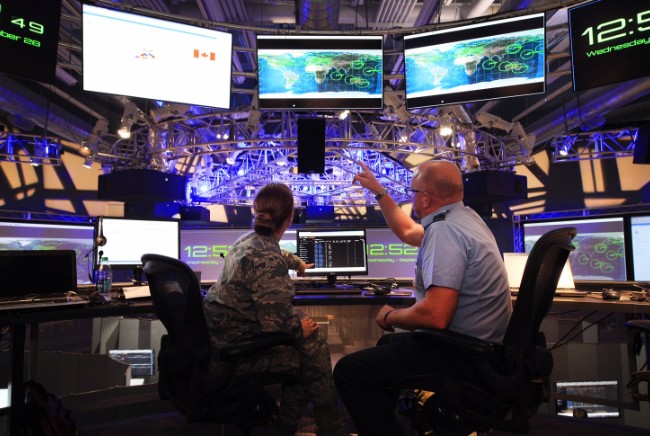
Participants conduct simulated space operations during a US Strategic Command-led space situational awareness tabletop exercise in 2016. STRATCOM is working with others in the military to decide which organization should be in charge of synchronizing non-kinetic effects, like those in cyber and electronic warfare, for combatant commanders. DOD photo by Adam Hartman.
The Joint Staff is leading a series of exercises and wargames to decide who should manage the Pentagon’s range of kinetic and non-kinetic attacks, from missiles to electronic warfare, in combat as part of “globally integrated operations,” according to the nominee to lead US Strategic Command.
The outcomes will be key data points that shape how the military approaches multidomain operations and expands its toolbox to include new weapons in cyberspace, the electromagnetic spectrum, and more. It’s also of interest to STRATCOM, which is adjusting to an era in which strategic operations and deterrence encompasses more than nuclear weapons.
Vice Adm. Chas Richard said the findings will shape his view on whether STRATCOM should be in charge of synchronizing non-kinetic fires for commanders across the globe.
“There’s a joint nature to this that we need to bring it together,” Richard, currently the Navy’s commander of submarine forces, said of electronic warfare at his Oct. 24 confirmation hearing before the Senate Armed Services Committee. “The services are doing individual things that we are just in the beginnings of putting the joint interoperability pieces on this to the level that we need. We have multiple individual service concepts of operation. We have not pulled those together in a more current, total, joint look across all services.”
The Pentagon is pursuing a vision in which non-kinetic effects are more interchangeable with and connected to traditional weapons, recognizing that a physical attack or defense may not always be the most effective in digital-era warfare.
Richard said he recently turned electronic warfare into a main combat focus in his organization and is taking steps to regrow EW specialists who dedicate their careers to that area. He argued that the military services should invest in EW capabilities that work with others across the Defense Department, adding that there’s still much work to be done to understand how EMS operations are—and can be—conducted across the joint force.
“Our military’s ability to operate in the electromagnetic spectrum is being contested in a way that we have not seen in a long time,” he said. “It is no longer a permissive environment. I could draw parallels to what is happening in the cyber domain and the space domain.”
DOD has some, but insufficient, methods of testing and training with electronic warfare technologies. In his answers to advance policy questions posed by the committee, Richard said the spectrum is so congested that it increasingly constrains the ability to do open-air testing.
“There are few ranges where advanced electronic warfare testing can take place; often these locations are forced to cease testing due to unintended interference,” he wrote. “These challenges also affect the manner by which the joint force trains. Despite renewed emphasis and efforts to fund and fix, the department’s simulation capability is still limited.”
Some EW-related infrastructure improvements are being rolled out at test and training ranges, and the Defense Advanced Research Projects Agency is looking into certain forms of simulation that could give DOD the capability it needs.
DOD is also looking for new ways to gain situational awareness on the electromagnetic spectrum, and for tools that can command and control offensive and defensive EMS operations.
As more commercial entities access and expand their use of the spectrum—think 5G networks, among other efforts—Richard said DOD must have the ability to rapidly assess how auctioning off parts of the spectrum could affect military programs. Federal agencies must work together to make sure DOD can operate without interference, he added.
“The spectrum continues to be constrained by increased commercial use, limiting the availability for operational, training, and testing purposes,” he said. “We must achieve a balance—where possible—to advance new virtual approaches enhancing joint electronic warfare capabilities and training without dependence on spectrum access.”